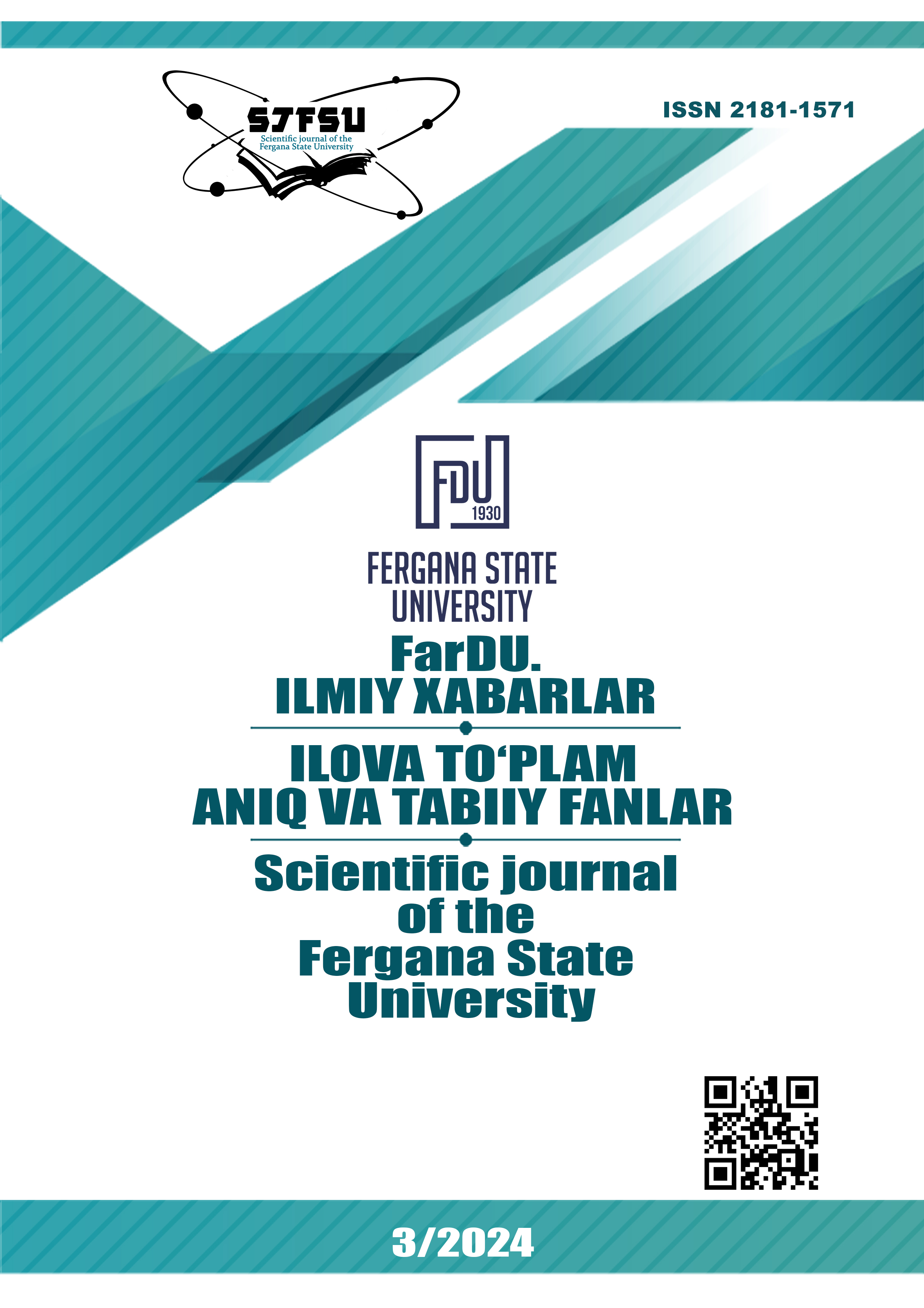BIOECOLOGY OF SILK BERRY VARIETIES
Keywords:
mulberry plant, quantitative and qualitative indicators, varietal characteristics, environmental factors, productivityAbstract
This article studies the biological and environmental features of the Tajikistan mulberry plant, seedless mulberry varieties Sanish-41, Yuzhny, Sanish-38, Sanish-33, Sanish-39. The quantitative and qualitative indicators of the varieties in the experiment were assessed by the determination method. Among the quantitative indicators of varieties in the experiment, they take into account the number of trees per calculation (pcs.), the number of branches with leaves (kg), the mass of leaves (%), the number of leaves in pure form (kg), the mass of leaves of one tree (kg), the yield of . When determining the quality indicators of varieties in the experiment, such indicators as swelling of buds, formation of 5 leaves, closure of apical buds, and flowering time were determined. We studied the yellowing of leaves, the time of leaf fall, and the growing season (days). The area of the experimental plot is 3300 m2, the soil is light gray soil, irrigated, soil fertility is average, plant varieties in the II tier, in the IV repetition, R.A. Placed according to the randomization method recommended by Fisher. In our experiments conducted in 2019-2020-2021, several mulberry varieties were simultaneously controlled; Tajikistan m/s was taken as a control. Environmental factors influenced the qualitative and quantitative indicators of the varieties in the experiment, and among the tested varieties, the Sanish-39 and Sanish-38 varieties were superior to the Tajikistan s/m variety in all their indicators. The variety Sanish-38 differed from other tested varieties in the abundance of branches and the dense arrangement of leaves on the branches. For the Sanish-39 variety, the average yield was 132 c/ha, which is +6 more than the control, especially in favorable weather, the leaf yield reached 154 c/ha. This figure was +16 c/ha compared to the Tajikistan m/s variety
References
O‘zbekiston Respublikasi Prezidentining “Pillachilik tarmog‘ida ipak qurti ozuqa bazasini rivojlantirish bo‘yicha qo‘shimcha chora-tadbirlar to‘g‘risida” PQ-4567-son 17.01.2020 yildagi qarori.
Ch.I. Bekkamov, U.T. Daniyarov, N.K. Abdikayumova, N.O. Rajabov “ lpakchilik va tutchilik” Cho‘lpon nomidagi nashriyot-matbaa ijodiy uyi Toshkent — 2019
Методика испытания сортов шелковицы и гибридов тутового шелкопряда Москва. 1984
Mahammadovna, A. D. (2023). ATROF-MUHIT MUHOFAZASIDA CHIQINDILAR MUAMMOSI VA UNING YECHIMI. Journal of new century innovations, 37(1), 194-198.
Ахмедова, Д. М. (2023). ВЗАИМОВЛИЯНИЕ ПИТАТЕЛЬНЫХ ВЕЩЕСТВ В ПОЧВЕННЫХ СРЕДАХ У ХЛОПЧАТНИКА. World of Science, 6(5), 6-12.
Ahmedova, D. (2023). EKOLOGIK DEHQONCHILIK VA UNING ISTIQBOLI. Science and innovation, 2(Special Issue 6), 133-136.
Ahmedova, D., & Turdimatova, H. S. (2022). PROBLEMS OF PRODUCTION OF ENVIRONMENTALLY FRIENDLY PRODUCTS. Journal of Academic Research and Trends in Educational Sciences, 1(12), 12-16.
Ахмедова, Д. М. (2022). ГЕНОМНЫЙ АНАЛИЗ АЛЛОГЕКСАПЛОИДНЫХ ГИБРИДОВ ХЛОПЧАТНИКА. International scientific journal of Biruni, 1(2), 8-15.
Akhmedova, D., & Nazarov, M. (2019). Influence of environmental factors on bio-ecological features and its productivity”.
Ахмедова, Д. М. (2022). ГЕНОМНЫЙ АНАЛИЗ АЛЛОГЕКСАПЛОИДНЫХ ГИБРИДОВ ХЛОПЧАТНИКА. International scientific journal of Biruni, 1(2), 8-15.
Downloads
Published
Issue
Section
License
Copyright (c) 2024 Scientific journal of the Fergana State University

This work is licensed under a Creative Commons Attribution-NonCommercial-NoDerivatives 4.0 International License.
How to Cite
Most read articles by the same author(s)
- Dilfuza Yo‘ldosheva, MODERN PEDAGOGICAL METHODS OF DEVELOPING CREATIVE COMPETENCE OF FUTURE TEACHERS ON THE BASIS OF ACMEOLOGICAL APPROACH , Scientific journal of the Fergana State University: No. 1 (2023): Scientific journal of the Fergana State University (Social humanities sciences)
- , PROVIDING GUARANTEES OF RELIABLE PROTECTION OF THE RIGHTS AND FREEDOMS OF HUMANS AND CITIZENS. IMPROVEMENT OF ADMINISTRATIVE, CRIMINAL AND CIVIL LEGISLATION , Scientific journal of the Fergana State University: No. 5 (2023): Scientific journal of the Fergana State University (Social humanities sciences)
- , CONSTITUTIONAL FRAMEWORK FOR ENVIRONMENTAL RELATIONS , Scientific journal of the Fergana State University: No. 6- TOM (2023): SPECIAL ISSUE
- , , , DETERMINATION OF HEAVY METALS IN FOODS , Scientific journal of the Fergana State University: No. 2 (2023): Scientific journal of the Fergana State University (Exact and natural sciences)
- , , , ECOLOGICAL CHARACTERISTICS OF THE POND BIOCENOSIS , Scientific journal of the Fergana State University: No. 3 (2024): FarDU.Ilmiy xabarlar jurnali. Ilova to'plam (Aniq va tabiiy fanlar)
- , , , , , DEVELOPMENT AN EFFICIENT AND SELECTIVE OF DETECTION METHOD OF Fe (III) ION WITH AN IMMOBILIZED NITROSO-R-SALT , Scientific journal of the Fergana State University: No. 6 (2024): FarDU.Ilmiy xabarlar jurnali (Aniq va tabiiy fanlar)
- Dilfuza Gaziyeva , THE ROLE OF THE MEDIA TEXT IN THE MODERN COMMUNICATIVE SPACE , Scientific journal of the Fergana State University: No. 4 (2023): FarDU ilmiy habarlari jurnali (Ijtimoiy gumanitar)
- , MODERN PEDAGOGICAL METHODS OF DEVELOPING CREATIVE COMPETENCE OF FUTURE TEACHERS ON THE BASIS OF ACMEOLOGICAL APPROACH , Scientific journal of the Fergana State University: No. 2 (2023): Scientific journal of the Fergana State University (Exact and natural sciences)
- , , , , THE EFFECT OF BIOCHAR AND MINERAL FERTILIZERS ON MORPHOLOGICAL INDICATORS OF THE ROOT SYSTEM IN OKRA PLANT , Scientific journal of the Fergana State University: No. 2 (2024): FarDU.Ilmiy xabarlar jurnali (Aniq va tabiiy fanlar)
- Obidov Muzaffar, Botirova Durdigul, Shoxnoza Zakirova, Dilfuza Egamberdieva, BIOLOGICAL CONTROL OF COTTON DISEASE BY BACTERIAL AGENTS , Scientific journal of the Fergana State University: No. 3 (2024): FarDU.Ilmiy xabarlar jurnali. Ilova to'plam (Aniq va tabiiy fanlar)

